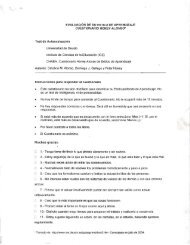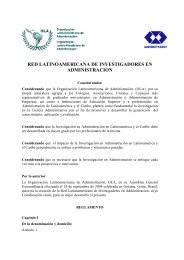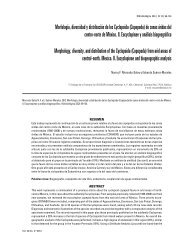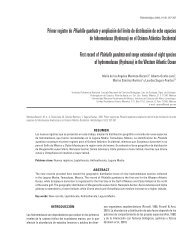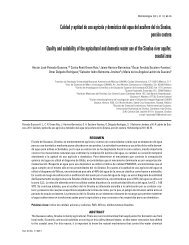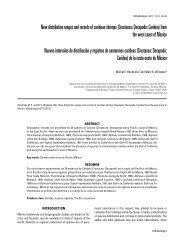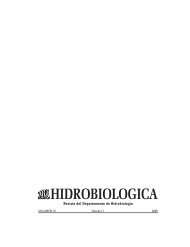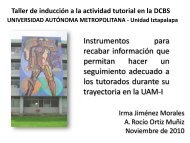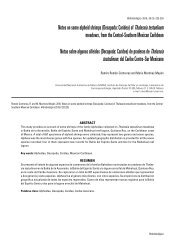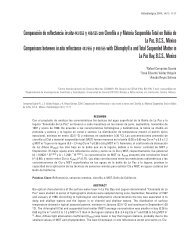Codium decorticatum
Codium decorticatum
Codium decorticatum
- No tags were found...
You also want an ePaper? Increase the reach of your titles
YUMPU automatically turns print PDFs into web optimized ePapers that Google loves.
2Miravalles, A. B., et al.a las gametas masculinas de otras algas verdes sifonales, como lo indican la morfología del aparato flagelar("capping plate" y "terminal caps") y la presencia de una gran mitocondria. De acuerdo a estas observaciones,concluimos que las poblaciones atlánticas argentinas producen sólo gametas masculinas. Por lo tanto, lagerminación agámica de gametas masculinas sería el único mecanismo de reproducción asexual de laspoblaciones argentinas. Posteriores estudios son necesarios para confirmar la hipótesis de que estaspoblaciones se reproducen asexualmente por germinación de gametas masculinas que en este caso puedenser consideradas zoósporas.Palabras claves: <strong>Codium</strong> <strong>decorticatum</strong>, gametogénesis, algas verdes sifonales, ultraestructura, utrículo.INTRODUCTIONThe genus <strong>Codium</strong> Stackhouse is characterized by thallicomposed by interwoven coenocytic filaments which form aloose and colorless medulla and an utricle palisade cortex(Borden and Stein, 1969b). Gametangia are borne laterally onutricle protuberances (Silva, 1960). The genus has been describedas having a pronounced anisogamy (Borden and Stein,1969b); however, Feldmann (1956), Dangeard and Parriaud(1956), Churchill and Moeller (1972), Rico and Pérez (1993) haveindicated the presence of only one type of gametes in <strong>Codium</strong>fragile, described as female gametes which germinateparthenogenetically.The available information on <strong>Codium</strong> species is fragmentary.Reproduction and differentiation at the optical microscopelevel in <strong>Codium</strong> fragile (Suringar) Hariot have beenstudied (Arasaki et al., 1956; Borden and Stein, 1969a,b; Churchilland Moeller,1972; Ramus,1972; Prince, 1988; Park andSohn, 1992; Rico and Pérez, 1993). Schussnig (1950) studiedgametogenesis at the optical microscope level in <strong>Codium</strong> <strong>decorticatum</strong>(Woodward) Howe and also there are caryologicalstudies of this species (Schussnig, 1950; Kapraun and Martin,1987, Kapraun et al., 1988). The only ultrastructural studiesdone in the genus consist of brief observations on chloroplastsand nuclei (Hori and Ueda, 1967; Roth and Friedmann,1980).The aim of this research is to study at the optical and ultrastructurallevel the utricle morphology and the gametogenesisprocess in field-collected thalli of <strong>Codium</strong> <strong>decorticatum</strong>populations growing along the Atlantic Argentinian coast.MATERIALS AND METHODSThalli of <strong>Codium</strong> <strong>decorticatum</strong> bearing gametangia indifferent stages of development were collected in PuertoMadryn, Province of Chubut (42º 46' S, 65º 03' W), in Las Grutas,Province of Río Negro (40º 44' S, 64º 56' W) and in BahíaSan Blas, Province of Buenos Aires (40º 34’ S, 62º 14’ W).Light microscopy studies were carried out with a LeitzSM Lux microscope and a Carl Zeiss Axiolab microscope withanoptral phase-contrast. For transmission electron microscopystudies, utricles and gametangia in different stages ofdevelopment were fixed in 2% glutaraldehyde in 0.1M cacodylatebuffer, postfixed in 1% OsO 4 , dehydrated in an acetoneseries, and embedded in Spurr’s low viscosity resin(Spurr, 1969) by the flat embedding method (Reymond and Pickett-Heaps,1983). Sections were cut with a diamond knifeand stained with uranyl acetate and lead citrate. Sectionswere observed with a JEOL 100 CX-II electron microscope atthe Centro Regional de Investigaciones Básicas y Aplicadasde Bahía Blanca (CRIBABB), Bahía Blanca, Argentina.Utricle structureRESULTS<strong>Codium</strong> <strong>decorticatum</strong> utricles were cylindrical, 1 mm longand somewhat dilated at the apex, measuring 250 µm wide (Fig.1). In transverse sections two zones were recognized: a largecentral vacuole and a circumvacuolar thin parietal layer of cytoplasm(Fig. 2). The vacuolar contents were homogeneous.Nuclei were adjacent to the cell wall in the outermostportion of the cytoplasm (Fig. 2). In interphase, they were polymorphicwith the main axis parallel to the utricle cell wall (Fig.2). They were 4 - 6 µm long and 1.5 - 3 µm wide. They had scarceheterochromatin distributed in the nucleoplasm and one ortwo prominent nucleoli. Dictyosomes, endoplasmic reticulumand mitochondria were also located in this region (Fig. 3). Vesiclescontaining either electron translucent contents or fuzzymaterial were adjacent to the plasmalemma (Fig 3).The chloroplasts placed in the innermost portion of theparietal cytoplasm protruded into the vacuole; they were fusiformand were oriented predominantly perpendicular to theutricle cell wall (Fig. 2). Chloroplasts with various featureswere observed in the same utricle: some of them presentedstroma mainly occupied by thylakoids, small starch granulesHidrobiológica



